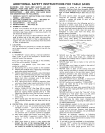
spreaderisinproperalignmentwiththesawblade,,
If rippingatthetime,checktoseeif theripfence
is parallel with the sawbladeReadjustas
indicated.
R. DO NOT remove small pieces of cut-off material
that may become trapped inside the blade guard
while the saw is running This could endanger your
hands or cause a kickback. Turn saw "OFF" and
wait until blade stops
S Use extra care when ripping wood that has a twisted
grain or is twisted or bowed -- it may rock on the
table and/or pinch the sawblade
10. KNOW YOUR CUTTING TOOLS
A. Dull, gummy, or improperly sharpened or set cutting
tools can cause material to stick, jam, stall the saw,
or kickback at the operator
Minimize potential injury by proper cutting roof
and machine maintenance,
NEVER ATTEMPT TO FREE A STALLED
SAWBLADE WITHOUT FIRST TURNING THE
SAW OFF,
B Never use grinding wheels, abrasive cut-off wheels,
friction wheels (metal slitting blades) wire wheels or
buffing wheels
11. USE ONLY ACCESSORIES DESIGNED FOR THIS
SAW_
12 Crosscutting operations are more conveniently worked
and with greater safety if an auxiliary wood facing is
attached to the miter gauge using the holes provided
However, the facing must not interfere with the proper
functioning of the sawbtade guard,
13 Make sure the top of the arbor or cutting tool rotates
toward you when standing in normal operating
position. Also make sure the cutting tool, arbor collars
and arbor nut are installed properly Keep the cutting
tool as low as possible for the operation being
performed Keep all guards in place whenever possible
14 Do not use any blade or other cutting tool marked for
an operating speed less than 3450 RPM Never use a
cutting tool larger in diameter than the diameter for
which the saw was designed For greatest safety and
efficiency when ripping, use the maximum diameter
blade for which the saw is designed since under these
conditions the spreader is nearest the blade
15. Adjust tabie inserts flush with the table top NEVER
Operate the saw unless the proper insert is installed
16. Never feed material into the cutting tool from the rear
of the saw. An accident and serious injury could result.
17 Always maintain control of the workpiece -- DO NOT
"let go" of the workpiece until the cutting tool has
come to a stop.
18. IF YOUR SAW MAKES AN UNFAMILIAR NOISE OR
IF IT VIBRATES EXCESSIVELY CEASE
OPERATING IMMEDIATELY UNTIL THE SOURCE
HAS BEEN LOCATED AND THE PROBLEM
CORRECTED.
19. If any part of this table saw is missing or should break,
bend or fail in any way, or any electrical component
fail to perform properly, shut off power switch, remove
cord from power supply and replace damaged, missing
and/or failed parts before resuming operation,
20. THINK SAFETY,
Safety [sa combination of operator common sense and
alertness at all times when the saw is being used.
21oNOTE AND FOLLOW SAFETY INSTRUCTIONS
THAT APPEAR ON THE FRONT OF YOUR SAW,
_N [_At_ER
BEFD_ 10p ERAT_ g_AAC Ht __._
WE_,n SAFETY GDG_LE_ J'En Ar_ ,_11 AT _,_.L
Tm!_!;
,_ u,_ A ,,pUSt! =;T_cK'r W_tEN _Eo_*r_E D
22. WARNING: DO NOT ALLOW FAMILIARITY
(GAINED FROM FREQUENT USE OF YOUR SAW)
TO BECOME COMMONPLACE, - ALWAYS
REMEMBER THAT A CARELESS FRACTION OF A
SECOND IS SUFFICIENT TO INFLICT SEVERE
INJURY.
The operation of any power tool
WEAR YOUR can result in foreign objects being
thrown into the eyes, which can
result in severe eye damage° Always
wear safety goggles complying with
ANSI Z87.1 (shown on Package)
before commencing power tool
operation, Safety Goggles are
available at Sears retail or catalog
stores
MOTOR $PEC FICATIONS AND ELECTRICAL REQUIRE ENT$
MOTOR SPECIFICATIONS
The AC motor used in this saw is a capacitor start,
non-reversible type, with the following specifications:
Voltage ............................ 240
Amperes .............................. 7
Hertz ................................... 60
Phase ................................. Single
RPM ......................................... 3450
Rotation (viewed from
sawblade end) .................. Counterclockwise
MOTOR SAFETY PROTECTION
The saw motor is equipped with a manual-reset thermal
overload protector, designed to open the power line circuit
when the motor temperature exceeds a safe value.
1. if motor [s overloaded and overload protector is
actuated (stopping motor) BE POSITIVE you push
switch "'OFF" immediately and allow the motor to cool
before attempting to reset the protector. Since the
protector is near the sawblade, the switch must not be
turned "ON" until after you have reset the protector
2 If the red button will not snap into place immediately,
3,,
4_
PROTECTOR
(RED BUTTON)
the motor is still too hot and must be allowed to cool
for a while longer.
As soon as the red button will snap into running
position, the saw may be started and operated normally
by moving the saw switch lever to the "ON" position.
Frequent opening of fuses or circuit breakers may result
if motor is overloaded, or if the motor circuit is fused
with a fuse other than those recommended. Do not use
a fuse of greater capacity without consulting the power
company_


















